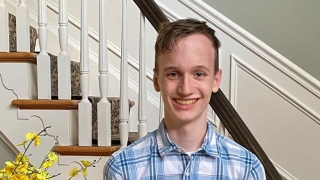Posterior Spinal Fusion for Scoliosis During the COVID-19 Crisis: Sean’s Story
Published on
Published on
When the COVID-19 pandemic delayed the plans for posterior spinal fusion surgery to correct Sean’s worsening scoliosis, CHOP Orthopaedics worked with Sean’s family to get him back in the door as soon as it was safe to do so. Any worries the family had were quickly eased when they arrived at CHOP and saw the safety precautions in place. Sean is now recovered from surgery, brace-free and back to his favorite activities.
 Sean had a really big growth spurt between the ages of 11 and 12, says his mom, Trish. At an annual physical, the pediatrician took note of the youth’s increased height. The physician also noticed that Sean’s shoulders were slightly uneven and his spine was curved, so he referred the family to Children’s Hospital of Philadelphia Orthopaedic Surgeon Jason Anari, MD, for a scoliosis evaluation.
Sean had a really big growth spurt between the ages of 11 and 12, says his mom, Trish. At an annual physical, the pediatrician took note of the youth’s increased height. The physician also noticed that Sean’s shoulders were slightly uneven and his spine was curved, so he referred the family to Children’s Hospital of Philadelphia Orthopaedic Surgeon Jason Anari, MD, for a scoliosis evaluation.
Fortunately for Sean’s family, Dr. Anari sees patients at the CHOP Care Network Specialty Care Center in Chalfont, Pa., which is near their home in Bucks County. Dr. Anari performed an evaluation and diagnosed Sean with adolescent idiopathic scoliosis. The curve in Sean’s spine was 40 degrees; if the spine continued to curve, it might eventually cause heart or lung problems.
Dr. Anari recommended Sean wear a brace in the hopes that it would stop or at least delay progression of the curve to prevent Sean from needing surgery. As an active kid on the swim and basketball teams, it was hard for Sean to stay in the brace for the prescribed 18 hours a day, but he did it. He slept in the brace and wore it to school, taking it off only for practices and games.
At a follow-up appointment a year later, Dr. Anari noticed that, despite Sean wearing the brace diligently, another big growth spurt had caused the curve in his spine to progress to 57 degrees. Dr. Anari recommended Sean undergo posterior spinal fusion surgery. It’s an invasive procedure that involves screwing rods to the spine to pull it straight; it would correct Sean’s spine in a way the brace couldn’t.
Plans for the surgery were delayed, however, as the COVID-19 crisis took hold in early March 2020, just a few days after the appointment. Pennsylvania’s governor imposed a stay-at-home order for the state, and CHOP cancelled all non-emergency appointments and procedures in an effort to flatten the transmission curve and conserve personal protective equipment for frontline healthcare workers.
When the state’s restrictions around COVID were loosened and CHOP resumed elective procedures in early May, Sean was one of the early spine patients to undergo surgery. Having a major surgical procedure during the pandemic definitely added a level of stress, says Trish. With four kids, an elderly parent, and a spouse who is an emergency medicine physician at a local adult hospital, Trish and her family were taking every precaution to stay safe from the virus. Her worries were quickly eased when the family arrived at CHOP for the surgery and saw the safety precautions in place.
“They really know what they are doing and they do it well,” Trish says of the hospital and its staff. “We were put at ease, and it made us not as worried about our son. Everybody did their job with a smile and reassurance. It was handled so professionally.”
“I know CHOP is the best place to go for care, so I knew my son would be well taken care of,” she adds. “But what really impressed me the most about the whole experience is that even in the midst of the pandemic, they had a really good sense for how difficult it is for parents. I felt like I was being taken care of as well. Just the way the staff spoke to us and answered our questions. We were never rushed.”
CHOP’s spine surgeons recently published an article providing guidance on pediatric spine surgery prioritization in the COVID-19 era, which was published in the Journal of Bone and Joint Surgery.
 Sean’s recovery after surgery was remarkable, says Trish. This is due to the Rapid Recovery Pathway utilized by Dr. Anari and other members of the Spine Program team.
Sean’s recovery after surgery was remarkable, says Trish. This is due to the Rapid Recovery Pathway utilized by Dr. Anari and other members of the Spine Program team.
The pathway combines a pain management approach with rehabilitation to reduce the rate of surgical complications, ease recovery, and get patients home faster with their pain under control. Before implementation of the pathway, scoliosis surgery patients typically went home five to six days after surgery. Today, the length of stay is usually three to four days at most.
Sean, 14, spent only two days in the hospital after surgery and was able to get back to swimming less than two months later. Now 5 months after surgery, he has been entirely pain-free since recovering from the surgery and is back to full function.